Full photos and more posts can be viewed on our X (formerly Twitter) – Glenwood Family Centre X
Here is a snapshot of some of the experiences the children enjoyed during September …
Full photos and more posts can be viewed on our X (formerly Twitter) – Glenwood Family Centre X
Here is a snapshot of some of the experiences the children enjoyed during September …
By Mrs Rodger
The children in the Willow room have been doing a lot of tinkering! They have been exploring electronic equipment and took apart an old speaker, DVD player, and laptop.
They have been using fine motor skills and hand eye coordination to take screws out using a screwdriver. They have been using their gross motor skills to help pull parts of the objects apart.
“This is so cool”
“Look what’s inside this.”
“ This is fun.”
“I did it. Look, the screw is out.”
by Mrs Wilson
 Last year we planted some wildflower seeds in tyres in the garden and seeds from these plants have started growing this year. The children were keen to plant some more wildflower seeds and we decided to do this by first making some seed balls.
Last year we planted some wildflower seeds in tyres in the garden and seeds from these plants have started growing this year. The children were keen to plant some more wildflower seeds and we decided to do this by first making some seed balls.
Seed balls are a really great way to plant wildflower seeds in your garden or outdoor area. Making the seed balls will not only introduce children to the variety, shapes and sizes of different seeds, but also develop their gardening skills as they learn about what seeds need to grow and how they can support wildlife in their garden or outdoor area.

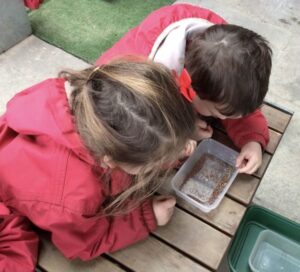
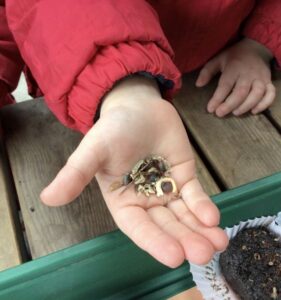

“The bees will like these flowers when they grow.”
After planting and watering the seed balls the children are now looking forward to observing the wildflower seeds grow and hopefully welcoming some bees and butterflies and other creatures into our garden.
When the wildflowers have grown they will add a variety of colours where they have been planted, providing food and shelter for insects and other creatures. Wildflowers are also greatly important for pollinators such as bees so they can carry pollen from one plant to the next.
Why not have a go at home by following our recipe and help support wildlife in your area, or try the recipe below to make recycled paper wildflower seed balls.
https://scottishwildlifetrust.org.uk/resource/make-recycled-paper-wildflower-seed-balls/
by Miss McCallum
This year’s theme for British Science Week was time.
We followed the instructions and made our own sand timers. We used a stopwatch to count how long our sand timer ran for. It was two minutes.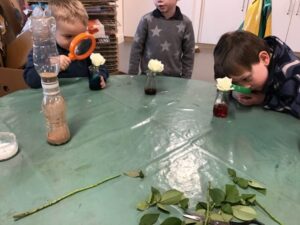
Using our sand timers we timed how long it took for our colour changing flower experiment to work. We made predictions on how many times we would need to turn the timer over.
by Mrs Clark
Learning about time is an important skill for children because it is something they will use throughout their whole life.
At Glenwood, we use routines, events and play activities to link with times and seasons to help build our children’s awareness.
Calendars are a fantastic resource to encourage talk about important events such as birthdays and annual celebrations, and we use these to help our children to learn about dates, days of the week and months of the year.
We play games such as ‘What’s The Time, Mr Wolf?’ to develop children’s understanding of o’clock and the numbers on a clock face ranging from 1-12.
Having the opportunity to use clocks and watches encourages our children to record and display their own ideas about time and build an understanding of both analogue and digital time.
We make connections to the changing seasons as we access daily outdoor play and look at resources that we wear or use. This helps our children to develop an awareness of the features of the four seasons.
On a daily basis we also make use of visual timetables, sand timers for turn taking, sing songs, look at books and use online resources to help our children have a greater understanding of time. We also talk about different times of the day e.g. morning, afternoon, evening, and use language associated with time e.g. now, then and next.
We hope that this gives you some inspiration for things you can try at home!
by Mrs Wilson
The children have been very busy over the last few weeks planning and preparing everything we need to get ready to start planting in our nursery garden.
We made a floor map to add our ideas about what we needed to do and what we would like to grow.

One of the ideas from the floor map was to plant pumpkin seeds so we could grow our own for Halloween. We learned that pumpkin seeds are planted on their sides and when they are growing they will need lots of water.

We have been developing our fine and gross motor skills as we used trowels to dig out weeds and turn over the soil in our raised beds so the soil is prepared for planting. Some of the children remembered that last year some of our plants were eaten by slugs, so we decided to go on a slug hunt in the garden so we could remove them.
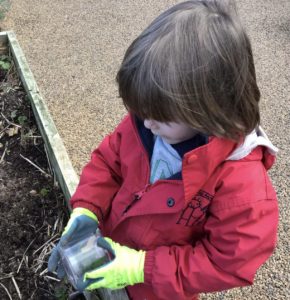
Using soapy water and sponges we washed out old plant pots so they are ready for planting our new seeds.
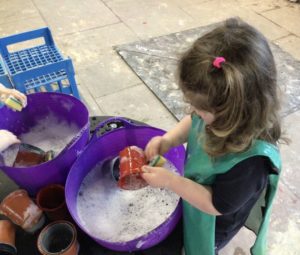
Potatoes are always a favourite to grow with the children at our family centre. We used our observation skills and magnifying glasses to learn about chitting seed potatoes to allow the eyes to grow before we can plant them.

To decide what we are going to plant we used buttons to choose our three favourite fruits or vegetables to grow in the garden.
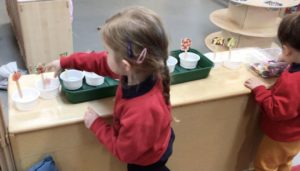
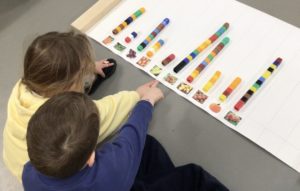
We made a graph using unifix cubes to help interpret the results of our fruit and vegetable survey.
The children are now looking forward to planting in the garden. This will help to develop their knowledge and understanding about how the different plants grow and how to look after them, as well as the opportunity to taste a variety of fresh fruits and vegetables when they are ready to harvest.
Further information about growing fruits, vegetables and flowers and gardening with children can be found on the following websites:
https://www.rhs.org.uk/education-learning/gardening-children-schools/family-activities/grow-it
https://www.gardenersworld.com/plants/tips-for-gardening-with-children/
by Miss Bibby
We have been busy baking at Glenwood. First, we researched what we wanted to bake and looked at a range of recipes. We chose one for gluten free shortbread. Then, we talked about what ingredients and equipment we needed and we set up the table. The children were discussing the different measurements they would need and they worked as a team to weigh out the shortbread ingredients.

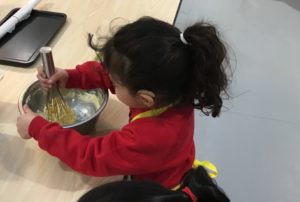


by Miss Chrystal
We have recently introduced the Virtual Nature School program within our centre. This term, we have been using natural resources to develop speech and language skills through a range of activities, all led by the children’s interests.
The children have developed their communication skills through a variety of different water and mud play experiences. This has enabled the children to explore new vocabulary, talk about their ideas and think about how things change within the natural environment.
Water
The children have been exploring the different ways that we can experiment with water and colour change. We made our own clouds and rain using shaving foam and food colouring.
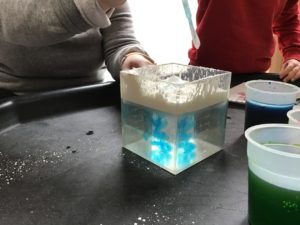
The children became confident at using a range of resources such as pipettes and paintbrushes. They were able to describe the change of state when the ice melted and also describe the colour changes that took place in the water.
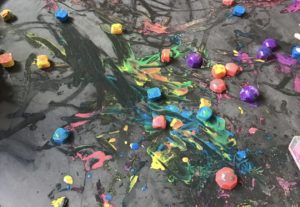
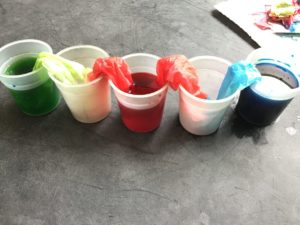
We also explored different pictures of water experiences and the children discussed of what they associate each picture with:

Mud
The second element we explored was mud. The children led their own learning within this block with staff observing the children’s play. We were fortunate that it rained so we put on our wellies and waterproofs and went to play in the mud.
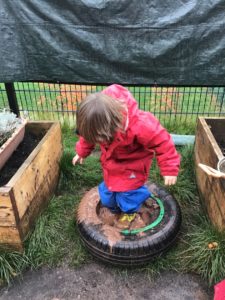
The children were engrossed in their play. They used their imaginations and they were confident to express their ideas and interests. They created their own mud paint as well as using paper to create muddy footprints from their wellies.
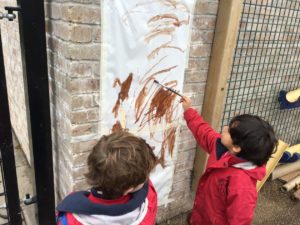
The children developed their confidence by talking and exploring a variety of vocabulary when asked to describe the texture of the mud.
“It is squelchy!”
“The rain has made it all gooey and sticky!”
by Miss Callaghan
The children have been enjoying participating in a wide range of science activities this month. This provides a great opportunity for children to explore materials and observe changes.
“What happens if I mix that one and that one (yellow & red). It’s orange!”
We have been exploring colour mixing with primary colours and pipettes. The children have been growing their confidence in using charts for information and have been using them effectively to make choices and plan which colour they would like to mix. The pipettes have been great for developing fine motor skills and children have enjoyed discussions around colours and how they change.
“I want to make green – I need blue and yellow. It’s green!”
We then focused on using different materials to investigate change and colour. The children used glue to create a pattern on a piece of paper then covered it in salt. Children were able to use their problem solving skills to predict what would happen when they used the pipettes to drop colour onto the salt and glue.
“I think the colours will mix.”
“It moves slow!”
“It looks like fireworks that I went to watch.”
The children were excited to see the colour droplets expand as they travelled through the salt and when they added another colour beside it, the colour would mix and travel.
Lastly, we expanded on our materials and made puffy paint. The children used flour, baking powder, salt and food colouring and mixed it together to make a cake-like consistency. This also involved the use of instructions and a recipe, the children were able to recognise numbers and count out how much they needed. The last set of instructions was to put our creation into the microwave for 30 seconds and watch the painting come to life! The picture puffed up and the children were delighted with the result, this was a great opportunity to explore cause and effect and it left an open ended opportunity for discussion.
When we returned after the Christmas break, we noticed some of the containers left outdoors were full of ice. We thought of how the ice had formed and how to get the ice out.
Indoors, we decided to explore ice in different ways. We froze some water and used pipettes and coloured water to investigate the melting ice.

As a nursery community, we are on a continuous journey to empower our children to improve their environmental awareness.
There are lots of wonderful ideas that you can do as a family to learn more about the natural world and care for the environment, which supports STEM and literacy learning, as well as your child’s health and wellbeing.
Introduce your children to the concept of sorting household rubbish for recycling into categories such as plastic, paper, metal and glass. This is a fantastic opportunity to learn about different types of materials used for packaging, how they are made and how they can be reused.
National Geographic have a great online game to do a recycle round-up and clean up the park: https://kids.nationalgeographic.com/games/action-and-adventure/recycle-roundup-new/
Instead of throwing things away, encourage your child to think of great ways to reuse items. Egg cartons work really well for growing herbs, glass jars are perfect for storing loose parts for play, and tin cans make really good pen and pencil holders.
COMPOST
Composting helps to teach our children about reducing the waste that heads to landfills by converting it into nutrient-rich soil.
There are lots of free and easy ways for your family to start composting.
Use a recycled plastic drinks bottle – https://www.changeworks.org.uk/sites/default/files/Make_compost_in_a_bottle.pdf
Recycle some wooden pallets – https://www.rspb.org.uk/get-involved/activities/give-nature-a-home-in-your-garden/garden-activities/startcomposting/
You could also simply create a compost trench in your garden or use an old bin or container – https://aggie-horticulture.tamu.edu/Kindergarden/kidscompost/CompostingForKids.pdf
So what should you put in?
 Greens – these are things that rot quickly, and provide important nitrogen and moisture
Greens – these are things that rot quickly, and provide important nitrogen and moisture
Browns – these are things that rot more slowly. They provide carbon and fibre and also allow air pockets to form
Visit a local park and spend some time cleaning up the litter. You will not only be protecting the wildlife and caring for the world around you but you will also be helping your community. It will hopefully inspire others to join in too. Count how many bits of rubbish you find – you will be amazed! Don’t forget to wear protective gloves and take a rubbish bag.
You don’t have to go far to encounter some amazing living things. Going on a back garden safari in your own garden or to a local park or woods will be a real voyage of discovery. It is such a fun way to explore and learn about local plants, animals and minibeasts. You can simply sit and watch, take photos or a video, do a scavenger checklist or record what you found by drawing a picture.
There is lots of information on the WWF to help you get started – https://www.wwf.org.uk/learn/love-nature/garden-safari
GROWING FRUIT AND VEGETABLES
Getting your child involved in growing fruit and vegetables is a great way for them to learn where their food comes from and make healthy eating choices. Children can see first hand the growing cycle and develop an awareness of the seasonal nature of food.
Try growing indoors whilst the weather is still cold. Tomatoes, carrots, peppers and beans work well on a nice sunny windowsill using a recycled container that allows drainage.
https://kidsgardening.org/gardening-basics-indoor-gardening/
 Spring is coming soon and the perfect time to start growing outdoors if you have the opportunity. You can plant in tubs, make a raised bed or create a garden growing patch.
Spring is coming soon and the perfect time to start growing outdoors if you have the opportunity. You can plant in tubs, make a raised bed or create a garden growing patch.
Fruits and vegetables that are easy to grow and mature quickly are strawberries, lettuce, peas, radishes, and courgettes.
https://www.bbcgoodfood.com/howto/guide/easy-crops-kids-grow
We would love if you could share your learning from home with us so we can use it as part of our action plan, either via Google Classroom or Twitter @GlenwoodFC #Glenwoodlearningfromhome
Mrs Silvester has been having fun with her recycling again! Here are some ideas of things you could try at home too…
Catapults
 In Mrs Silvester’s house we set out to build our own catapults with things we had around the house to see if we could create our own trajectory devices. Then we built a basketball type game with the catapults.
In Mrs Silvester’s house we set out to build our own catapults with things we had around the house to see if we could create our own trajectory devices. Then we built a basketball type game with the catapults.
Here are some of the things you could use:
These were some of the questions the children in my house had, which we were hoping the experiment would answer:
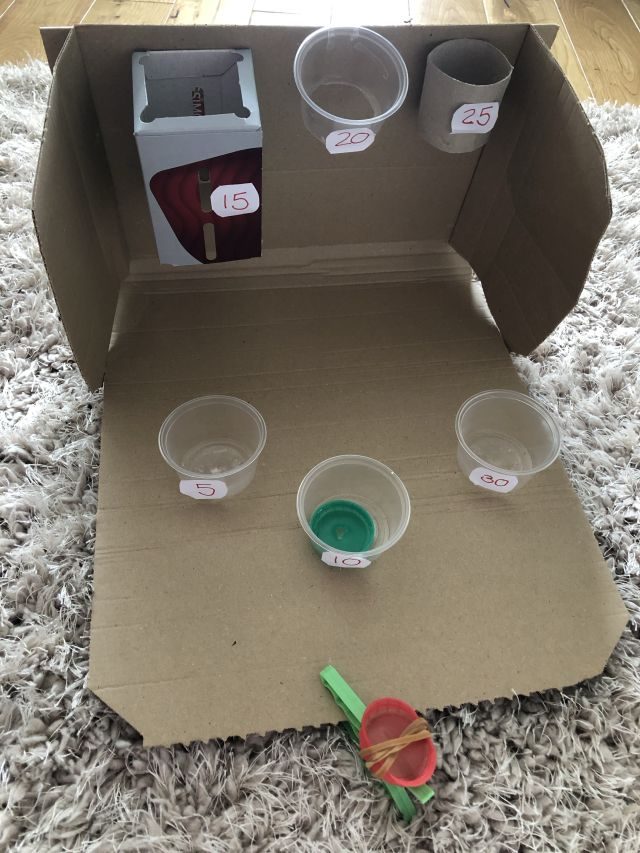
Find more information
https://www.scouts.org.uk/activities/lolly-stick-catapults/
Maze Game
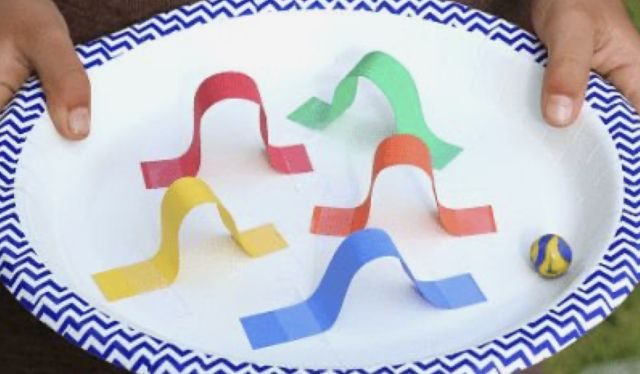 This game was fun to make and is great for building motor skills, concentration, counting and number recognition. Turn a cardboard box or plate into an entertaining ball maze game. This is a great hand-eye coordination game to make and play with reusable materials.
This game was fun to make and is great for building motor skills, concentration, counting and number recognition. Turn a cardboard box or plate into an entertaining ball maze game. This is a great hand-eye coordination game to make and play with reusable materials.
Suggestions of what you could use to make your own Recycled Maze Game:
Create the Maze
1) Design your maze by placing the tubes or paper strips on the box. Arrange them making sure you leave enough space for free ball travel around the maze.
2) Then attach the tubes or paper strips to your box or plate
3) ENJOY ! ! !
You could try these other ideas for making mazes too.
Here’s a fun song to help remind us of ways to cut down on single use plastic: https://www.bbc.co.uk/iplayer/episode/p0798jzc/junk-rescue-songs-2-single-use-no-thank-you
Don’t forget to share your creations on Google Classrooms or Twitter @GlenwoodFC #Glenwoodlearningathome
Children are naturally scientists – their curiosity helps them to understand the world around them. The children at Glenwood love to do their own experiments – developing their skills of scientific inquiry and creativity as they work.
They ask questions and make predictions, follow instructions and make observations, developing skills for learning, life and work.
Here are a few simple experiments and investigations you can try at home…
Click on the link to find out how to Make a Bubble Snake
 Here is a reminder of the bubble mix recipe:
Here is a reminder of the bubble mix recipe:
1/2 cup of washing up liquid, 1 1/2 cups water & 2 teaspoons of sugar
You could use straws or other tubes to blow bubbles (or anything else with holes…)
Make a Paper Aeroplane (follow the link for instructions)
Which is the best design for flying fast?
Which goes the furthest?
Why don’t you have a competition with your whole family?
Create a Volcanic Eruption
This is a favourite at Glenwood – it can get messy so you might like to do it outside!
 First make your volcano – you could use an empty plastic bottle or yoghurt pot and some sand or mud.
First make your volcano – you could use an empty plastic bottle or yoghurt pot and some sand or mud.
Next put some bicarbonate of soda in the volcano (along with some ketchup or food colouring or paint to make the lava red)
Finally pour in some vinegar and watch the eruption!
Lego Boat Challenge
Can you make a boat that floats using Lego?
How many pennies can it hold before it sinks?
Another challenge for the whole family to get involved with!
Build a Bug Hotel
You could create a home for minibeasts in your garden – it can be big and fancy like the one on the RSPB website but a simple one using recycled materials will also attract wildlife.
Don’t forget there are some other science experiments in your Ideas for Home Booklet March 2020
Please Tweet some photos @GlenwoodFC #Glenwoodlearningathome
Thank you to all the parents who attended our recent STEM curriculum evening and to the whole staff team for showcasing our learning and making this evening a huge success. Our parents loved trying out some of the experiences on offer and feedback was very positive and encouraging.
Great to see all the stimulating and fun activities and nice to talk with staff and parents.
So lovely to see the amazing resources and have a chance to meet other staff members – really lovely group.
Thank you for all the staff’s knowledge and expertise!
The resources were fantastic, in particular the technology.
Loved the ideas for playing and learning at home and seeing what children do at nursery.
I wish I could provide constructive feedback, but nope! The evening and it’s content was perfect! So much effort made! Such a shame more parents didn’t come along.
If you didn’t manage along, see what you missed here STEM in Glenwood presentation









